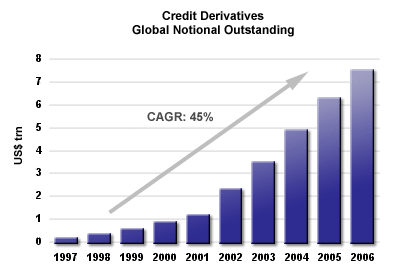Credit Derivatives: Friend or Foe?
Abstract
| Boston, MA, USA January 30, 2004 The credit derivatives industry is expected to be worth over US$7 trillion notional outstanding by 2006.  The credit derivatives market has developed at a breathtaking rate. In the early 1990s the market was virtually nonexistent; by 2002 it was valued at slightly over US$2 trillion notional outstanding and Celent expects it to exceed US$7 trillion by 2006. And new types of credit derivative products have been introduced at a dizzying pace. In a new report, ?, Celent examines the driving forces of the market and the factors that could possibly derail it. Credit derivatives still account for just slightly more than one percent of the overall market for derivative contracts among commercial banks. However, the overall derivatives market increased less than three-fold from 1997 to 2003, while the credit derivatives market grew nearly sixteen times over. "Relative to other derivative products, the market for credit derivatives is still in its relative infancy but growing at a rapid pace," says Adam Josephson, research analyst in the securities and investments group at Celent and author of the report. As a sign of the market痴 increasing maturity, credit indices now come from different providers, and a heated battle has ensued over which set of indices will emerge as the industry standard. Both claim to be attracting significant liquidity and to be close to getting credit derivative contracts listed on an exchange. However, Celent expects TRAC-X, the index introduced by JP Morgan and Morgan Stanley, to eventually emerge with all the liquidity over iBoxx. TRAC-X has more global coverage, has attracted greater volumes and is further along in getting listed on an exchange. As exchange-traded indices become a reality, many more participants will flock to the market. The ISDA and market participants will continue to prove capable of addressing legal matters as they arise. And the front-to-back office solutions available to market participants will continue to improve, thereby helping smaller firms with fewer resources participate in the market, and the larger participants will make the operational adjustments necessary to ensure a stable marketplace. A is available online. | |
of Celent Communications' Institutional Securities & Investments, Wholesale Banking, Life/Health Insurance, and Property/Casualty Insurance research services can download the report electronically by clicking on the icon to the left. Non-members should contact info@celent.com for more information. | |
|

